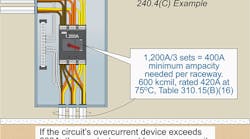Code Q&A: Overcurrent Protection Devices and Conductor Ratings
Q. Does the NEC rule for rounding up of overcurrent protection devices for conductors change above any specific amperage?
See the answer below.
This answer is based on the 2017 NEC.
A. Yes, it does. If the circuit’s overcurrent protection device exceeds 800A, the conductor ampacity ― after the application of ambient temperature correction [310.15(B)(2)(a)], conductor bundling adjustment [310.15(B)(3)(a)], or both ― must have a rating of not less than the rating of the overcurrent protection device defined in Sec. 240.6 [240.4(C)].
Conductors to overcurrent devices rated over 800A are typically installed in parallel. In these cases, the ampacity rating applies to the set of parallel conductors instead of the individual conductors.
Let’s run through an example problem to make sure you understand these requirements.
Example: A 1,200A overcurrent device feeds conductors that are parallel in three raceways. What is the minimum ampacity needed for the conductors? (see Figure)
Answer: 1,200A.
The parallel conductors must have an ampacity of 1,200A. 1,200A ÷ 3 raceways = 400A minimum ampacity needed in each parallel set. A 600kcmil conductor is rated for 420A at 75°C. Therefore, this is the minimum size ungrounded conductors allowed for this installation.
These materials are provided to us by Mike Holt Enterprises in Leesburg, Fla. To view Code training materials offered by this company, visit www.mikeholt.com/code.






